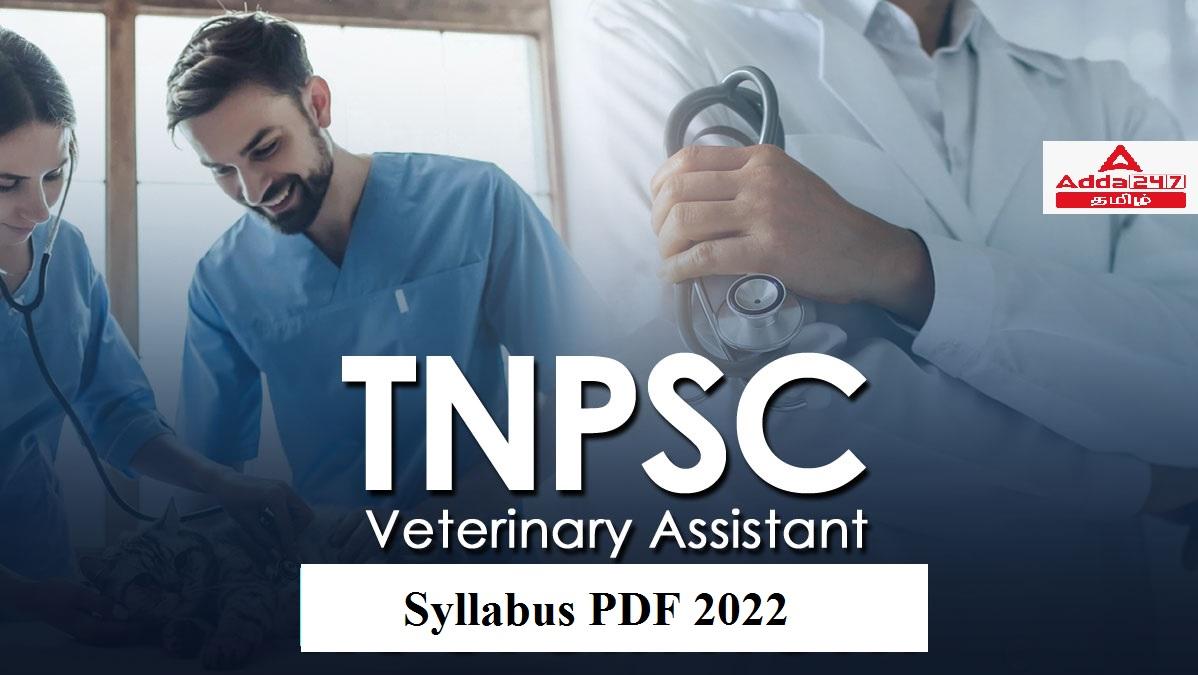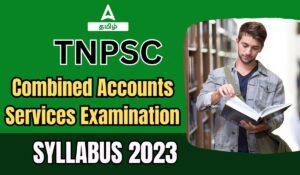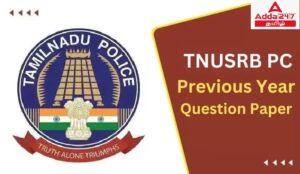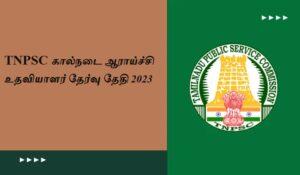Table of Contents
TNPSC Veterinary Assistant Syllabus: TNPSC released the official notification for Veterinary Assistant Surgeon Post. Candidates who are preparing for TNPSC Veterinary Assistant must go through to Lastest TNPSC Veterinary Assistant syllabus 2022. Candidates can check TNPSC Veterinary Assistant Syllabus here. We are also providing the direct link for TNPSC Veterinary Assistant Syllabus 2022 pdf download.
Fill the Form and Get All The Latest Job Alerts
| TNPSC Veterinary Assistant Syllabus | |
| Organization Name | Tamilnadu Public Service Commission (TNPSC) |
| Vacancy | 731* |
| Post Names | TNPSC Veterinary Assistant |
| Category | Syllabus |
| Job Location | Tamilnadu |
| Official Site | tnpsc.gov.in |
TNPSC Veterinary Assistant Syllabus
TNPSC Veterinary Assistant தமிழ்நாடு அரசுப் பணியாளர் தேர்வாணையம் (TNPSC) 731 கால்நடை உதவி அறுவை சிகிச்சைக்கான காலியிடங்களை அறிவித்துள்ளது. அவர்களின் TNPSC அமைப்பில் சேர இது ஒரு சிறந்த வாய்ப்பு.விண்ணப்பதாரர்கள் தங்கள் தேர்வுக்கு தயாராவதற்கு உதவியாக TNPSC Veterinary Assistant தேர்வின் விரிவான TNPSC Veterinary Assistant பாடத்திட்டத்தை இந்த கட்டுரையில் வழங்கியுள்ளோம்.
TNPSC Veterinary Assistant Syllabus 2022
SYLLABUS FOR EXAMINATION (CBT Method)
ANIMAL HUSBANDRY AND VETERINARY SCIENCE
(UG DEGREE STANDARD)
CODE NO.296
UNIT – I : GENERAL
Role of livestock and their products in Indian economy and human health, current livestock programmes and policies of State and Nation – Economics of dairy, sheep, goat, poultry, pig and rabbit farming; constraints to the livestock development programs, common offences against animals – SPCA, Animal Welfare Board of India, NGOs.
UNIT – II : LIVESTOCK MANAGEMENT
Common terms used in Animal Husbandry – Identification of age of animals – Livestock and poultry breeds and breed characters; housing systems, and requirements of space, ventilation, water, sanitation and waste disposal. Management of milk, meat, egg and wool producing livestock, breeding bulls and draft animals and wild animals in captivity, farm records and their maintenance,systems and strategies for livestock improvement for enhancing productivity.
UNIT – III : LIVESTOCK NUTRITION
Nutritional terms and definitions – Role of nutrition in health and production;
classification and composition of feed and fodders including forest grasses; antinutritional factors and toxins in feeds and fodders; feeding standards and nutrient requirements of different categories of livestock / poultry and computation of rations.
Nutritional deficiency and its influence on livestock performance; feed supplements and additives; conservation and preservation of feed and fodders; economic utilization of agro by products for feeding livestock – Utilisation of unconventional feeds – Wildlife nutrition.
Quality control of feed, feed block/baling, By-Pass Proteins and by-pass Fat, Feeding livestock during scarcity, Metabolic disorders in Livestock and Poultry, Processing of feeds and forage to improve nutritive value.
UNIT – IV : LIVESTOCK BREEDING AND GENETICS
Important breeds of cattle, buffalo, sheep, goat, pig and poultry with special reference to economic characters – Important species of wild animals and their breeding in captivity. Selection of Livestock for production, reproduction and disease resistance traits. Principles of genetics and basis of population genetics, genetic parameters. Nature of DNA and RNA-their models and functions; applications of recombinant DNA technology, cloning and marker Assisted selection and Cytogenetics. Animal breeding policies and programmes in state
and Nation.
UNIT – V : VETERINARY ANATOMY, PHYSIOLOGY AND BIOCHEMISTRY
Gross study of bones, joints and muscles of skeleton Gross study of heart and its conduction system. Gross study of organs of digestive, respiratory urinary and reproductive systems. Digestion, metabolism and absorption of carbohydrates, proteins and fats in simple stomach animals and ruminants – mechanism of respiration. General functions of blood (blood cells, plasma & serum) coagulation, cardiac cycle, Blood circulation, Blood pressure, renal function Hormonal control of Lactogenesis. Environmental factors affecting animal production –
Environmental stress on animal performance – Green Houses Gases – Role of ruminants.
UNIT – VI : VETERINARY MICROBIOLOGY, VETERINARY PREVENTIVE
MEDICINE
Bacteriology & Mycology: Classification – isolation, identification and culturing of bacteria and fungi -Methods of transmission of infection – Sterilization anddisinfection – Antibiogram. Virology: Classification, – cultivation, replication General characteristics of various families of RNA and DNA viruses. Immune system organs, tissues and cells; infection and immunity; type and grade of immunity, serological reactions and modern diagnostic techniques – vaccine. Epidemiology – Concept, Scope, Objectives and Uses. Monitoring and surveillanceepidemiological disciplines. Pathogenesis, clinical signs, differential diagnosis,
prevention and control of common bacterial, viral, fungal, rickettsial and parasitic diseases of livestock, poultry and pet animals including wild life species- Regional, endemic, emerging and re-emerging important disease. Allergic skin tests and modern diagnostic techniques.
UNIT – VII : PATHOLOGY AND PARASITOLOGY
Concept and causes of diseases in animals; general principles and procedures of necropsy; collection, preservation and dispatch of morbid materials for laboratory diagnosis, disease investigation; common pathological conditions seen in domestic, wild, zoo and laboratory animals and birds. Vetro-legal implications. Classification of Parasites – Parasite and parasitism in animals; important morphological features, life-cycles, mode of transmission, pathogenesis, diagnosis, chemotherapy and general control measures of parasites associated with disease in animals, birds and zoo animals.
UNIT – VIII : PHARMACOLOGY
Drug action – Pharmacokinetics (absorption, distribution, biotransformation and excretion), Pharmacodynamics – local and general anesthetics. Antibiotics and chemotherapy – Toxicology – Ethnoveterinary practices.
UNIT – IX : VETERINARY CLINICAL MEDICINE, VETERINARY
GYNAECOLOGY AND OBSTETRICS AND VETERINARY SURGERY AND
RADIOLOGY
General and special clinical examination, etiology, clinical signs, pathogenesis, diagnosis, prevention and control of metabolic, deficiency diseases. Ethics and jurisprudence in domestic and wild animals. Reproductive physiology; hormones and reproduction; Accidents of gestation, livestock fertility and infertility; artificial insemination; semen characteristics of different species of livestock and cryopreservation. Multiple ovulation and embryo transfer technology in livestock and zoo animals Reproductive disorders and their management.
General surgical principles – Pre and post-operative considerations, anesthesia,asepsis and anti-sepsis and sterilization; scope, history and development of veterinary radiology; Imaging pathology of different parts of body-surgical emergencies – Intensive care – Physiotherapy – Diathermy.
UNIT- X : LIVESTOCK PRODUCTS TECHNOLOGY
Ante mortem and Post mortem inspection – Objectives of meat inspection – Abattoir practices, methods of slaughtering and dressing; Meat Inspection Laws, utilization of by products; unsound meat and its disposal; quality control of meat and eggs and their products. Milk: Proximate Composition, milk collection, cooling / chilling and transportation; physio-chemical and nutritional characters of milk and milk products; processing of raw milk and production of market milk. Condensed and dried milk, special milk and Indian Dairy Products – Packaging and storage. Cleaning and sanitization of dairy equipments and plants; role of microorganisms in milk and milk products; legal standards and quality assessment
of milk and milk products-role of milk and milk products, meat and egg in human nutrition – Detection of adulterants in milk. Good Manufacturing Practices (GMP) in dairy and Hazard analysis in critical control point (HACCP) in dairy Processing. FSSAI laws.
Paper-II
SYLLABUS FOR EXAMINATION (CBT Method)
PART – A
TAMIL ELIGIBILITY TEST (SSLC STANDARD)
- பிரித்தெழுதுதல்/சேர்த்தெழுதுதல்.
- எதிர்ச்சொல்லை எடுத்தெழுதுதல்.
- பொருந்தாச்சொல்லைக் கண்டறிதல்
- பிழை திருத்தம் (i) சந்திப்பிழையை நீக்குதல் ( ii) மரபுப் பிழைகள், வழுவுச் சொற்களை நீக்குதல் பிறமொழிச்சொற்களை நீக்குதல்
- ஆங்கிலச்சொல்லுக்கு நேரான தமிழ்ச்சொல்லை அறிதல்.
- ஒலி மற்றும் பொருள் வேறுபாடறிந்து சரியான பொருளையறிதல்.
- ஒரு பொருள் தரும் பல சொற்கள்.
- வேர்ச்சொல்லைத் தேர்வு செய்தல்.
- வேர்ச்சொல்லைக் கொடுத்து வினைமுற்று, வினையெச்சம், வினையாலணையும் பெயர், தொழிற்பெயரை உருவாக்கல்
- அகரவரிசைப்படி சொற்களை சீர் செய்தல்.
- சொற்களை ஒழுங்குப்படுத்தி சொற்றொடராக்குதல்.
- இருவினைகளின்பொருள் வேறுபாடு அறிதல் (எ.கா.) குவிந்து குவித்து
- விடைக்கேற்ற வினாவைத்தேர்ந்தெடுத்தல்.
- எவ்வகை வாக்கியம் என க்கண்டெழுதுதல் – தன்வினை, பிறவினை, செய்வினை, செயப்பாட்டு வினைவாக்கியங்களைக் கண்டெழுதுதல்.
- உவமையால் விளக்கப்பெறும் பொருத்தமான பொருளைத்தேர்ந்தெழுதுதல்
- அலுவல்சார்ந்தசொற்கள் (கலைச்சொல்)
- விடைவகைகள்
- பிறமொழிச் சொற்களுக்கு இணையான தமிழ்ச் சொற்களைக் கண்டறிதல் (எ.கா.) கோல்டுபிஸ்கட்-தங்கக்கட்டி
- ஊர்ப்பெயர்களின்மரூஉவை எழுதுக (எ.கா.) தஞ்சாவூர்-தஞ்சை
- நிறுத்தற்குறிகளை அறிதல்
- பேச்சுவழக்கு, எழுத்து வழக்கு வாரான்-வருகிறான்).
- சொற்களை இணைத்து புதிய சொல் உருவாக்கல்
- பொருத்தமானகாலம் அமைத்தல் (இறந்தகாலம், நிகழ்காலம், எதிர்காலம்).
- சரியான வினாச்சொல்லைத் தேர்ந்தெடு
- சரியான இணைப்புச் சொல் (எனவே, ஏனெனில், ஆகையால், அதனால், அதுபோல).
- அடைப்புக்குள் உள்ள சொல்லைத் தகுந்த இடத்தில் சேர்க்க.
- இருபொருள்தருக.
- குறில் நெடில் மாற்றம், பொருள்வேறுபாடு
- கூற்று காரணம் சரியா? தவறா?
- கலைச்சொற்களை அறிதல் எ.கா.- Artificial Intelligence – செயற்கை நுண்ண றிவு Super Computer -மீத்திறன் கணினி
- பொருத்தமானபொருளைத் தெரிவு செய்தல்
- சொற்களின் கூட்டுப்பெயர்கள் (எ.கா.) புல் புற்கள்
- சரியான தொடரைத்தேர்ந்தெடுத்தல்
- பிழைதிருத்துதல் ஒரு.ஓர்)
- சொல்-பொருள் பொருத்துக
- ஒருமை-பன்மை பிழை
- பத்தியிலிருந்து வினாவிற்கான சரியான விடையைத் தேர்ந்தெடு
Paper-II
PART – B
GENERAL STUDIES (DEGREE STANDARD)
CODE NO.003
UNIT-I: GENERAL SCIENCE
(i) Scientific Knowledge and Scientific Temper – Power of Reasoning – Rote Learning vs Conceptual Learning – Science as a tool to understand the past, present and future.
(ii) Nature of Universe – General Scientific Laws – Mechanics – Properties of Matter, Force, Motion and Energy – Everyday application of the Basic Principles of Mechanics, Electricity and Magnetism, Light, Sound, Heat, Nuclear Physics, Laser, Electronics and Communications.
(iii) Elements and Compounds, Acids, Bases, Salts, Petroleum Products, Fertilisers, Pesticides.
(iv) Main concepts of Life Science, Classification of Living Organisms, Evolution, Genetics, Physiology, Nutrition, Health and Hygiene, Human Diseases.
(v) Environment and Ecology.
UNIT-II: CURRENT EVENTS
(i) History – Latest diary of events – National symbols – Profile of States – Eminent personalities and places in news – Sports-Books and authors.
(ii) Polity – Political parties and political system in India-Public awareness and General administration- Welfare oriented Government schemes and their utility, Problems in Public Delivery Systems.
(iii) Geography-Geographical landmarks.
(iv) Economics-Current socio-economic issues.
(v) Science-Latest inventions in Science and Technology.
(vi) Prominent Personalities in various spheres – Arts, Science, Literature
and Philosophy.
UNIT-III: GEOGRAPHY OF INDIA
(i) Location – Physical features – Monsoon, Rainfall, Weather and Climate – Water Resources – Rivers in India – Soil, Minerals and Natural Resources – Forest and Wildlife – Agricultural pattern.
(ii) Transport -Communication.
(iii) Social Geography – Population density and distribution- Racial, Linguistic Groups and Major Tribes.
(iv) Natural calamity – Disaster Management – Environmental pollution: Reasons and preventive measures – Climate change – Green energy.
UNIT–IV: HISTORY AND CULTURE OF INDIA
(i) Indus Valley Civilization – Guptas, Delhi Sultans, Mughals and Marathas – Age of Vijayanagaram and Bahmani Kingdoms – South Indian History.
(ii) Change and Continuity in the Socio – Cultural History of India.
(iii) Characteristics of Indian Culture, Unity in Diversity –Race, Language, Custom.
(iv) India as a Secular State, Social Harmony.
UNIT-V: INDIAN POLITY
(i) Constitution of India – Preamble to the Constitution- Salient features of the Constitution- Union, State and Union Territory.
(ii) Citizenship, Fundamental Rights, Fundamental Duties, Directive Principles of State Policy.
(iii) Union Executive, Union Legislature – State Executive, State Legislature – Local Governments, Panchayat Raj.
(iv) Spirit of Federalism: Centre-State Relationships.
(v) Election – Judiciary in India – Rule of Law.
(vi) Corruption in Public Life – Anti-corruption measures – Lokpal and Lok Ayukta – Right to Information- Empowerment of Women-Consumer Protection Forums, Human Rights Charter.
UNIT-VI: INDIAN ECONOMY
(i) Nature of Indian Economy – Five year plan models – an assessment – Planning Commission and Niti Ayog.
(ii) Sources of revenue – Reserve Bank of India – Fiscal Policy and Monetary Policy – Finance Commission – Resource sharing between Union and State Governments – Goods and Services Tax.
(iii) Structure of Indian Economy and Employment Generation, Land Reforms and Agriculture – Application of Science and Technology in Agriculture – Industrial growth – Rural Welfare Oriented Programmes – Social Problems – Population, Education, Health, Employment, Poverty.
UNIT-VII: INDIAN NATIONAL MOVEMENT
(i) National Renaissance –Early uprising against British rule – Indian National Congress – Emergence of leaders –B.R.Ambedkar, Bhagat Singh, Bharathiar, V.O. Chidambaranar Jawaharlal Nehru, Kamarajar, Mahatma Gandhi, Maulana Abul Kalam Azad, Thanthai Periyar, Rajaji, Subash Chandra Bose, Rabindranath Tagore and others.
(ii) Different modes of Agitation: Growth of Satyagraha and Militant Movements.
(iii) Communalism and Partition.
UNIT-VIII: History, Culture, Heritage and Socio-Political Movements
in Tamil Nadu
(i) History of Tamil Society, related Archaeological discoveries, Tamil Literature from Sangam Age till contemporary times.
(ii) Thirukkural : (a) Significance as a Secular Literature
(b) Relevance to Everyday Life
(c) Impact of Thirukkural on Humanity
(d) Thirukkural and Universal Values – Equality, Humanism, etc
(e) Relevance to Socio-Politico-Economic affairs
(f) Philosophical content in Thirukkural
(iii) Role of Tamil Nadu in freedom struggle – Early agitations against British Rule – Role of women in freedom struggle.
(iv) Evolution of 19th and 20th Century Socio – Political Movements in Tamil Nadu – Justice Party, Growth of Rationalism – Self Respect Movement, Dravidian Movement and Principles underlying both these Movements, Contributions of Thanthai Periyar and Perarignar Anna.
UNIT–IX: Development Administration in Tamil Nadu
(i) Human Development Indicators in Tamil Nadu and a comparative assessment across the Country – Impact of Social Reform Movements in the Socio – Economic Development of Tamil Nadu.
(ii) Political parties and Welfare schemes for various sections of people – Rationale behind Reservation Policy and access to Social Resources – Economic trends in Tamil Nadu – Role and impact of social welfare schemes in the Socio-Economic Development of Tamil Nadu.
(iii) Social Justice and Social Harmony as the Cornerstones of SocioEconomic Development.
(iv) Education and Health Systems in Tamil Nadu.
(v) Geography of Tamil Nadu and its impact on Economic growth.
(vi) Achievements of Tamil Nadu in various fields.
(vii) e-Governance in Tamil Nadu.
UNIT-X: APTITUDE AND MENTAL ABILITY
(i) Simplification – Percentage – Highest Common Factor (HCF) – Lowest Common Multiple (LCM).
(ii) Ratio and Proportion.
(iii) Simple interest – Compound interest – Area – Volume – Time and Work.
(iv) Logical Reasoning – Puzzles-Dice – Visual Reasoning – Alpha numeric Reasoning – Number Series.
TNPSC Annual Planner 2023 to 2024 Out, Download PDF
TNPSC Veterinary Assistant Exam Pattern
| Subject
EXAMINATION in COMPUTER BASED TEST Method
|
Duration | Maximum Marks | Minimum qualifying marks for selection | |
| SCs, SC(A)s, STs,
MBCs/ DCs, BC(OBCM)s & BCMs |
Others | |||
| (i) Paper I Subject Paper ( UG Degree standard) – 200 Questions Animal Husbandry and Veterinary Science (Code No. 296 ) |
3 Hours | 300 | 153
|
204
|
| (ii) Paper II (Total 200 questions) Part-A Tamil Eligibility Test * (SSLC Std) (100 questions/ 150 marks) |
1.30 Hrs
1.30Hrs |
Note: Minimum qualifying marks –60 marks (40% of 150) Marks secured in Part-A of Paper-II will not be taken into account for ranking. |
||
| Part-B (General Studies) (Code No.003) (100 questions/ 200 marks) General Studies (Degree Std) -75 questions and Aptitude & Mental Ability Test (SSLC Std.) -25 questions(iii) Interview and Records |
200
70 |
|||
| Total | 570 | |||
TN Village Assistant Interview Call Letter 2022
TNPSC Veterinary Assistant Syllabus PDF
TNPSC Veterinary Assistant Syllabus தமிழ்நாடு அரசுப் பணியாளர் தேர்வாணையம் TNPSC கால்நடை உதவி மருத்துவர் பாடத்திட்டம் 2022ஐ வெளியிட்டுள்ளது. விண்ணப்பதாரர்கள் TNPSC கால்நடை உதவி அறுவை சிகிச்சை நிபுணர் CBT தேர்வு முறை மற்றும் தலைப்புகள் PDF இணைப்பை இங்கே சரிபார்த்து பதிவிறக்கம் செய்யலாம்.
TNPSC Veterinary Assistant Surgeon Syllabus PDF Download
TNPSC Veterinary Assistant Syllabus 2022 FAQs
Q1.What is the Exam Date for the TNPSC Veterinary Assistant Surgeon 2022?
The Exam Date for the TNPSC Veterinary Assistant Surgeon 2022 is 15.03.2023
Q2.What is the Selection Process for the TNPSC Veterinary Assistant Surgeon Recruitment 2022?
The Candidates will be Appointed after the Computer Based Test (CBT) Method and Interview Conducted by the Board.
Q3.What is the Registration Last Date for the TNPSC VAS Recruitment 2022?
The Registration Last Date for the TNPSC VAS Recruitment 2022 is 17.12.2022
***************************************************************************
To Attempt the Quiz on APP with Timings & All India Rank,
Download the app now, Click here
Adda247 பயன்பாட்டில் இந்த வினாடி வினாவை முயற்சிக்க இங்கே கிளிக் செய்து அகில இந்திய தரவரிசையைப் பெறுங்கள்
| Home page | Adda 247 Tamil |
| Latest Notification | TNPSC Recruitment 2023 |
| Official Website | Adda247 |
Use Code: 14BDAY (Double Validity + Flat 15% off on all Test Packs & Megapacks)
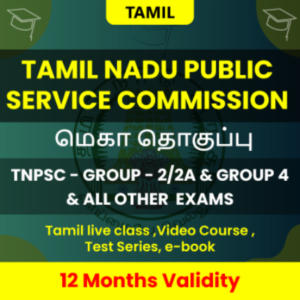
***************************************************************************
*இப்போது உங்கள் வீட்டில் தமிழில் நேரடி வகுப்புகள் கிடைக்கின்றன*
*பயிற்சி மட்டுமே தேர்வுர உங்களுக்கு உதவ முடியும் | Adda247 தமிழ் மூலம் உங்கள் பயிற்சியை இப்போது தொடங்கவும்*
Adda247App | Adda247 Tamil Youtube
Tamil Engineering Classes by Adda247Youtube link
Adda247 Tamil telegram group –Tnpsc sure shot selection group
Instagram = Adda247 Tamil

